All Resources

TestInvite, an anti-cheating exam software, operates entirely within web browsers, eliminating the need for any third-party installations like apps or extensions. With a wide array of anti-cheating measures, including proctoring and systematic randomization of test items, TestInvite is designed to prevent cheating in online exams and ensure the generation of reliable results.
To prevent some test-takers from having prior knowledge of the test questions, the test engine must randomize the test questions for each test-taker just before the test starts, while compiling an instance of the test. This ensures that no one can predict which questions will be asked in the test.
Randomizing questions indeed introduces another consideration. To ensure fair treatment of each test-taker and maintain balance in the assessment, it's crucial to implement a controlled randomization process. This means that while questions are randomized, certain constraints or rules can be applied to ensure that each test includes a proportional representation of questions from different subjects and difficulty levels. This way, fairness in the assessment is maintained, even with the randomization of questions.
This is why the suggested approach is to employ systematic randomization techniques, which enable the design of a test where each test item has its own set of questions to be chosen from. If certain questions are interconnected or linked to specific content, such as reading or listening materials, then groups of questions should be randomly selected from a list of alternative groups in those cases.
Systematic randomization combines the best of both worlds. On one hand, test-takers cannot predict the questions they will encounter, and on the other, each test-taker is treated equitably with an equal number of questions for each assessment objective and difficulty level. This ensures that the test remains both well-balanced and fair, while also maintaining its unpredictability.
Randomizing the order of test questions, answer choices, pages, sections, and questions can be a valuable strategy, especially in simultaneous online assessments. This approach eliminates the risk of test-takers communicating with each other to exchange responses and ensures a fair evaluation process. Because each test-taker encounters questions and answer choices in a unique sequence, there is no consistent pattern available for communication or cheating attempts
If a test-taker possesses advance knowledge of the test questions, no matter what precautions are taken, it becomes impossible to prevent misleading results because the test-taker can readily answer the questions with their foreknowledge of the answers.
This is particularly relevant in the case of online assessments, where test questions can be effortlessly shared and compromised. If your test is not administered simultaneously to all test-takers, there is a significant likelihood that some individuals will possess prior knowledge of the questions, potentially allowing them to achieve high scores without deserving them.
Applying time limits helps minimize cheating in online exams. However, their effectiveness is most pronounced when time restrictions are applied to specific aspects of the test, such as individual sections and pages, rather than using a single time limit for the entire test.
When a single time limit applies to the entire test, test-takers may have opportunities to seek outside help. However, when each section, and furthermore, each page, has its own smaller time limit, it becomes less likely for test-takers to find free time to attempt cheating.
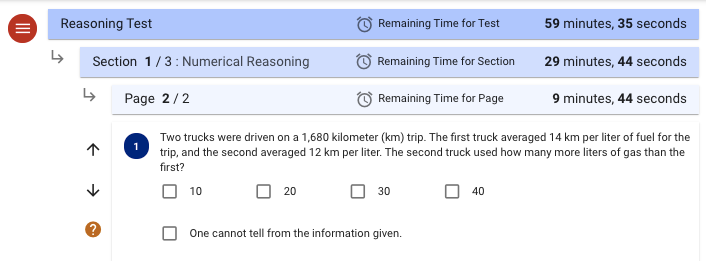
Implementing restrictions on how individuals can navigate and progress through a test can effectively deter certain cheating methods, particularly when candidates are unable to revisit questions after submitting their answers. Allowing for answer updates during the test creates more opportunities for cheating.
Preventing specific actions, like copying and pasting, significantly enhances cheating deterrence by increasing the difficulty and time required to transfer information from the test to external sources, including chat applications and web browsers.
Restricting the use of browser extensions like Grammarly and Google Translate can significantly increase the difficulty for candidates seeking assistance from other applications or extensions during the test.
Employing QR codes or barcodes that decode to the test-taker's session ID can not only aid in tracking compromised content but also act as a deterrent for test-takers attempting to copy test materials.
Screen locking and browser lockdown techniques significantly enhance the integrity of assessments by limiting a user's capability to access or engage with elements beyond the specific browser tab where the online test is being administered.
By preventing access to other applications, browsers, or tabs, these measures effectively minimize the risk of test-takers reaching out to external sources, thus promoting a more secure testing environment.
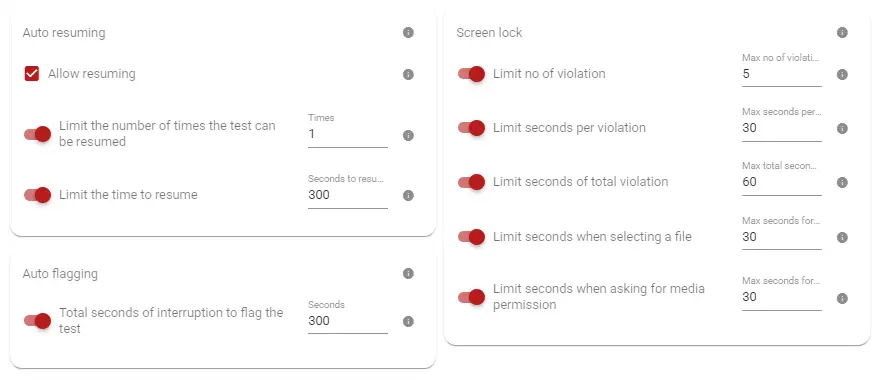
Screen recording is one of the effective ways to avoid cheating in exams. Screen recording of candidates is of paramount importance, as a significant portion of cheating attempts stems from using the same computer the test-taker is utilizing for the test. Comprehensive screen recording effectively thwarts various cheating attempts by providing a real-time view of all on-screen activities, thus significantly enhancing test integrity and security.
Additionally, screen recording simplifies the auditing and examination process, as it allows test administrators to review and verify test sessions in cases where there are complaints or discrepancies that require confirmation or validation. This comprehensive record of on-screen activities ensures transparency and facilitates the resolution of any issues that may arise during or after the test.
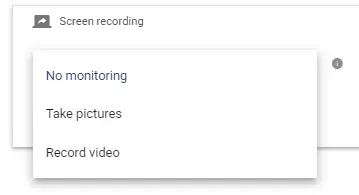
Real-time monitoring, using the live monitoring panel, enables test administrators to track candidates' start, progress, and completion of their test sessions in real-time. Having comprehensive insights into who has initiated the test, who hasn't commenced, the speed at which individuals progress through the test, and the number of participants who have terminated in real-time empowers test administrators with complete control over the process. This enables them to take timely actions when necessary.
Real-time monitoring significantly enhances the integrity of the assessment process by fostering honest behavior. It achieves this by bolstering control and oversight of the test-takers.

The live chat panel empowers test-takers to initiate text-based communication with test administrators at any stage: before, during, or after the test. This feature facilitates the timely asking of questions and enables test administrators to offer prompt support as required.
Conversely, test administrators can employ the chat panel to commence live conversations with any test-taker, ensuring they can swiftly reach out in case of suspicions related to cheating or other concerns. The act of delivering warnings or contacting individuals about urgent matters that demand immediate attention can play a crucial role in upholding the integrity of the assessment process.
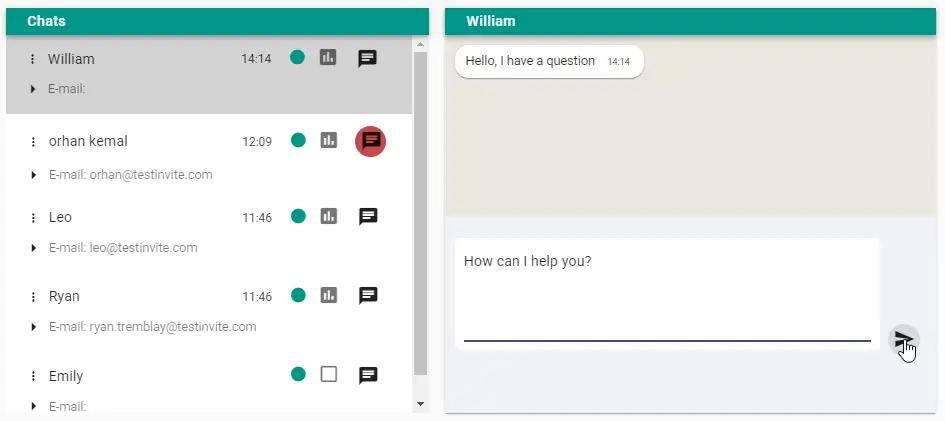
Recording the webcam of test-takers plays a crucial role in enhancing the integrity of the test in several ways. It not only reassures the identity of the test-taker but also ensures that they are the ones progressing through the test, providing multiple layers of security and authenticity.
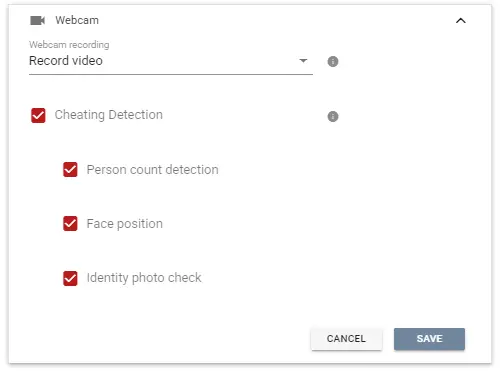
By harnessing the power of live proctoring tools, test-takers can be efficiently organized into smaller cohorts, each overseen by a dedicated human proctor responsible for monitoring webcam and screen feeds.
Live proctoring offers real-time supervision of test-takers' webcams, screens, and interactions within the testing environment, significantly reducing the chances of cheating on a proctored exam. This proactive approach not only upholds test integrity but also enables swift action when necessary.
Post-proctoring bears resemblances to live proctoring but differs in that it entails the oversight of candidates' webcam and screen recordings after their test sessions have concluded. An important feature is the ability to simultaneously select and monitor multiple test sessions, even if they occurred at different times, all from a single screen.
This versatility makes it a highly effective solution in various testing scenarios. Post-proctoring encompasses the review of all recorded media materials, encompassing webcam videos and screen recordings, with the aim of flagging instances where fraudulent activities are identified.

In the context of automated proctoring, materials captured during the test can also be subjected to analysis using trained artificial intelligence algorithms to identify fraudulent activities. This automated approach empowers human proctors to concentrate their efforts on flagged materials, expediting the resolution process and yielding substantial time savings.
To safeguard all assessments, it is imperative to implement access mechanisms such as usernames, passwords, PIN codes, user logins, or unique invitation codes. These measures ensure that individuals can exclusively access their own test sessions, enhancing security and data privacy.
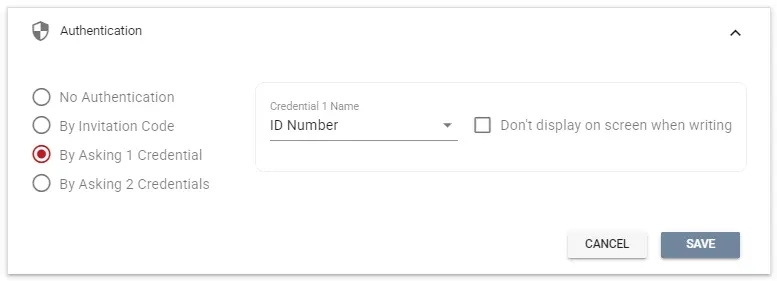
To verify the identity of the test-taker, it is essential to request the submission of identity or equivalent documents, which can significantly enhance security. Test-takers can also be prompted to take a photograph of themselves immediately before the test.
Webcam recordings, analyzed by an AI-backed algorithm, can then be reviewed to confirm that the face matches the photo. Lastly, the proctor can cross-reference the submitted identity documents with the photos taken before the test for added security.
It is crucial to log all events, actions, and submissions so that test administrators can later review and analyze specific moments as needed. This practice ensures that the assessment process aligns with expectations and the information provided by test-takers.
Recording IP addresses of connected devices, browser types, user agents, and other critical information like screen sizes can be highly beneficial for resolving events that are in doubt or under scrutiny.
The capability to halt a candidate's progress during an assessment empowers test administrators by enabling them to intervene in the event of suspicious activities. Additionally, test sessions can be reinstated at a later time by the test administrators, allowing the test-taker to resume their assessment from where they left off.
Unfortunately, no single anti-cheating feature can independently prevent cheating by itself. However, when multiple measures are implemented in concert, the overall integrity of the assessment process can be significantly enhanced.
From implementing time limits to utilizing webcam recording, restricting test-taker navigation options, and locking down the browser during testing, there are numerous measures you can adopt to enhance the integrity of your assessments and prevent misleading results. It is crucial to consider the requirements of your ideal testing scenario and the security measures you can integrate to ensure the utmost reliability of your results.
As we implement more comprehensive anti-cheating safeguards, the likelihood of test-takers attempting to cheat decreases. This not only discourages cheating but also redirects their efforts toward delivering their best performance, which is the ultimate goal of our endeavors.
Conversely, when fewer anti-cheating measures are in place, it can inadvertently encourage test-takers to explore ways to cheat, diverting their focus from genuine performance improvement. Therefore, by strengthening our security measures, we make cheating harder, more expensive, and riskier, ultimately fostering a test-taking environment where integrity and genuine performance shine.
How has the emergence of AI bots like ChatGPT changed cheating methods in online assessments and what steps can be taken to address this?
AI bots have made a significant impact across various domains, including online assessments. Their remarkable ability to provide quick and precise answers has made them an attractive resource for test-takers during assessments. To counteract the use of AI bots in online assessments, a combination of anti-cheating measures can be effectively employed.
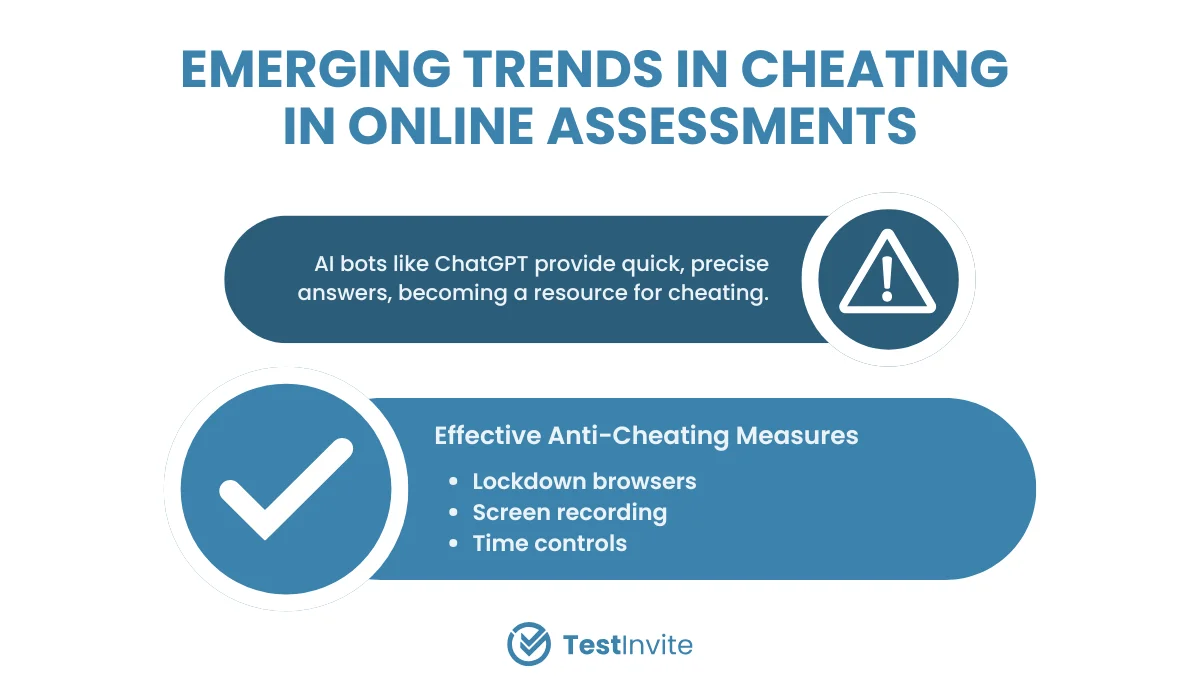
One primary measure involves implementing lockdown browsers, which restrict access to other tabs, windows, or apps on the same device being used for the test. This prevents test-takers from easily copying and pasting content into the assessment, a common method for utilizing AI bots, thereby reducing cheating during online exams.
Additionally, employing screen recording during the assessment serves as a powerful deterrent. It allows for the monitoring of the test-taker's on-screen actions, making it difficult for them to access external sources or interact with AI bots.
Finally, time controls can be applied on a per-question or per-page basis, limiting the test-taker's opportunities to seek external assistance and significantly reducing cheating attempts. These measures collectively work to maintain the integrity of online assessments and minimize the impact of AI bots.
Integrity in online assessments refers to the ethical and trustworthy conduct of the assessment process, ensuring that it is fair, transparent, and reliable. It encompasses measures and practices that prevent cheating, fraud, or any form of dishonesty during online tests or evaluations.
These measures include identity verification, secure test environments, proctoring, and anti-cheating technologies. Maintaining assessment integrity is essential to uphold the credibility and validity of online assessments, ensuring that the results accurately reflect a test-taker's knowledge and skills, and that the assessment process is conducted in a just and transparent manner.
Organizations should prioritize assessment integrity when the results of assessments have a significant impact on decisions related to individuals, such as hiring, promotions, validating their learning achievements, or awarding certifications.
In such cases, the accuracy and fairness of the assessment process are paramount to ensure that individuals are evaluated justly and that the decisions made based on these assessments are reliable and trustworthy. Maintaining assessment integrity is essential to uphold the credibility and validity of these decisions, ultimately contributing to the success and reputation of the organization.
